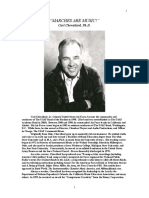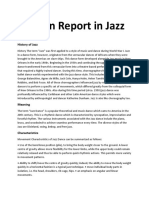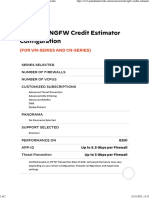Music APA Sample
Music APA Sample
Uploaded by
Modie MasangkayCopyright:
Available Formats
Music APA Sample
Music APA Sample
Uploaded by
Modie MasangkayOriginal Description:
Copyright
Available Formats
Share this document
Did you find this document useful?
Is this content inappropriate?
Copyright:
Available Formats
Music APA Sample
Music APA Sample
Uploaded by
Modie MasangkayCopyright:
Available Formats
Running head: MUSIC, DRILL AND HISTORY
Music, Drill and History
Student Name
Hallyburton Academy
English IV
1st Block
M. Vitrone
September 19, 2011
MUSIC, DRILL AND HISTORY
2
Music, Drill and History
Early Corps History
Drum and bugle corps comes from a rich American military history, separate from other
marching musical activities. Beginning after World War I through the 1970s, corps and
competitions were often sponsored by the VFW and the American Legion. Owing to these
groups' roots, corps was traditionally militaristic. By the late 1960s, many corps wanted more
creative freedom and better financial compensation than was offered by the sponsors. Some felt
the prize money structures, based on how well they scored, were not fairly compensating all
corps for their appearances. Additionally, some felt the current judging rules were going against
musical and theatrical possibilities. At the peak of American drum corps participation, several
corps decided to band together and form their own organizations, which ultimately led to the
formation of Drum Corps Associates (DCA) in 1965 and Drum Corps International (DCI) in
1972. By this time, many corps had already lost their church or community sponsors. For the
corps that remained, longer travel times were necessary to attend the contests, adding to the
financial and time demands on the organizations and their individual members. At the same time,
costs for the increasingly complex field shows mounted, and creative and instructional demands,
led many competitive corps to quit. By the late 1990s, only half of the corps that existed in the
60s and 70s remained; although several new corps, some of which have become very successful,
did start up along the way.
Modern Corps
Non-competitive classic-style corps saw a renaissance beginning in the mid 1980s, and
they continue to organize, members often remain vigilant about the traditions and virtues of the
drum corps activity. Freed from the traditional and more restrictive judging rules of the late
MUSIC, DRILL AND HISTORY
1960s, corps began making innovative changes such as the use of multi-valve horns, wideranging tempos, intricate asymmetric drill formations, elaborate guard costumes and props, and
the use of stationary percussion instruments. A common criticism of drum corps is that it has
become too close to marching band, although in truth the two activities have evolved together
over the years. The most apparent difference between the two is the fact that corps uses only
bell-front brass instrumentation. Some corps still utilize the traditional G Bugle which is very
rarely found in marching band. The competitive season for corps is in the summer rather than
fall, with auditions and initial ensemble rehearsals actually beginning as early as late October of
the previous year. The top-tier competitive drum corps programs are often far more difficult and
more professional than marching bands, as members in full time touring corps have no
distractions outside of corps during the season and you can only get in with a strict audition.
Marching Band Instrumentation
The size and composition of a marching band or drum corps can vary greatly. Some
bands have fewer than twenty members, and some have over 500. American marching bands
vary in their instrumentation.
Woodwinds.
Some bands omit some or all woodwinds, but it is not uncommon to
see piccolos, flutes, clarinets, alto saxophones, and tenor saxophones. Clarinets, alto
clarinets, bass clarinets, and baritone saxophones are less common, but can be found in some
bands. Bassoons and oboes are not found on a field due to the risk of incidental damage; the
impracticality of marching with an exposed double reed, and high sensitivity to weather makes
these instruments unusable during marching season.
MUSIC, DRILL AND HISTORY
Brass.
The brass section usually has trumpets or cornets, horns, alto horns,
or mellophones, tenor trombones, baritone horns or euphoniums, and tubas or sousaphones.
Soprano cornets are sometimes used to supplement or replace the high woodwinds. Some
especially large bands use flugelhorns and bass trombones. Specially designed versions of the
lower brass have been created for use while marching. These are typically wrapped in such a
way that allows the bell to face toward the audience at all times and makes the instrument easier
for the player to hold. Bands my also modify their instrumentation to remove slide trombones
completely and replace them with another instrument, such as a valve trombone or marching
baritone.
Percussion.
Marching percussion typically includes snare drums, tenor drums, bass drums,
and cymbals and is responsible for keeping tempo and is employed for its percussive impact. The
front ensemble which is on the front sideline consists of: guiros, and chimes or tubular bells,
concert bass drums, and gongs, as well as a multitude of auxiliary percussion equipment. Drum
sets, purpose-built drum racks, and other mounted instruments are also placed here. Until the
advent of the pit in the early 1980s, many of these instruments were actually carried on the field
by marching percussionists by hand or on mounting brackets. Some bands have eclectic
instruments too as synthesizers, electric guitars, and bass guitars, along with the
requisite amplification. Unusual percussive instruments are sometimes used, including brake
drums, empty propane tanks, trashcans, railroad ties, stomping rigs, and other cool sounds. Drum
Corps International (DCI), on the other hand, like the name suggests is a drum and bugle corps,
so it consists mainly of drums and bugles. In addition to drums and bugles, it also contains the
MUSIC, DRILL AND HISTORY
color guard and a front ensemble, but it has no woodwinds or other brass instruments. Some
drum corps are male only corps as well, like The Cavaliers and Madison Scouts (Drum Corps
International website, 2011).
Rules for Formations
There are a few simple rules when it comes to marching band or drum corps: play your
music, know your choreography, and get to your dot. When I say, Fit the form, I mean that if
there is a curve or a circle or a straight line, the players should stay behind the person in front of
them, keep their intervals the same to their left and right, and front to back. Players should stay
the same space apart; that way, the band gets a good general affect on the audience and judges.
The formations should appear as a big picture and not marchers getting to their dots, their set
coordinates.
Technique
When players start setting drill for a marching show or a DCI show, they get drill sheets,
and this gives them coordinates, such as Side 1, 2 steps outside 45 yard line, 7 steps in front of
front hash, and that is their dot, their spot on the field. There are two sides to the field; side A and
B. Side A is to the left of the 50 and side B is to the right of the 50. Since a football field is laid
off in sections of 5 yards, band members have some common practice steps to learn how to
march. The common steps to practice marching include: an 8 to 5 count, a 6 to 5 count, a 12 to 5
count, and a 16 to 5 count. However, when players are marching a show, there are some steps
that are smaller, some steps that are bigger, and if the players are lucky, sometimes they do not
have to move at all.
As visual programs have increased in complexity, corps have developed and formalized
various movement techniques, the goal of each being the achievement of fluid, consistent
MUSIC, DRILL AND HISTORY
movements that allow for precise musical technique at all tempos, step sizes, and directions.
Given that instrument-wielding members most often face toward the audience, marching
technique must not affect the motion of members upper body. Horn players may twist their
lower bodies in their direction of movement, but members of the battery cannot do that because
of their drums. This hindrance led to the invention of the crab step, where the legs cross over one
another to move side to side. Being visually oriented, color guard can face any direction at any
time, as long as their movement matches the choreography. The most common backward
marching technique requires that the band members balance on their toes and sort of drag them
across the ground; another technique instructs the members to reverse the heeltoe roll step,
allowing for heel and ground contact.
Marching technique programs have largely been inspired by dance technique, and
members of the color guard and horn-line often jazz run in order to maintain upper body stability
when marching at fast tempos with large step sizes. In addition, choreography has permeated all
sections of the contemporary drum corps, so not just color guard has visuals, but the horn-line
and battery and even front ensemble do as well.
Drill formations have become very sophisticated in modern corps. While traditional
blocks, company fronts, and symmetrical formations may still be used occasionally for impact,
they have largely given way to abstract formations and intricate developments aided by the use
of computer assisted drill writing programs. Drill writing is an art form unto itself, and is very
carefully written to keep instrumental sections together, to put featured members at the center of
attention, to visually reinforce musical phrasing, and to create the most interesting and
innovative shapes and movements (Drum Corps International Fan Network website, 2011).
MUSIC, DRILL AND HISTORY
Band Members Mentality and Dedication
It all winds down to how well band members want to do. Players will practice the way
they want to perform. Excellence is a habit, so band members who want to excel will practice
excellence and get used to doing it, every time all the time. Whether it be marching the show at
world finals or at their rehearsals, they will treat every run through like it is finals night.
MUSIC, DRILL AND HISTORY
8
References
Drum Corps International Fan Network website. (2011). http://dci.thefannetwork.org/
Drum Corps International website. (2011). http://www.dci.org/corps/
Drum Corps Planet website. (2011). http://www.drumcorpsplanet.com/
You might also like
- Thebushwackersofficialdancebook FreedownloadDocument30 pagesThebushwackersofficialdancebook Freedownloadapi-243600639No ratings yet
- Young Person Guia Benjamin BritenDocument34 pagesYoung Person Guia Benjamin Britenedmundo230468No ratings yet
- Kingston Irish TunebookDocument524 pagesKingston Irish Tunebookfrodlla79% (14)
- Jazz4Choirs Teaching Music PDFDocument14 pagesJazz4Choirs Teaching Music PDFRafael Ferreira100% (4)
- Christ Be Our Light-FarrellDocument1 pageChrist Be Our Light-FarrellModie MasangkayNo ratings yet
- Let Us Go To The AltarDocument1 pageLet Us Go To The AltarModie Masangkay0% (1)
- Marching Band: Goin' Band From Raiderland, A College Marching Band in The United StatesDocument27 pagesMarching Band: Goin' Band From Raiderland, A College Marching Band in The United StatesJohnNo ratings yet
- Marches RehearsalTechniquesPerformancePractices RobertJorgensen PDFDocument18 pagesMarches RehearsalTechniquesPerformancePractices RobertJorgensen PDFAmy Dunker100% (2)
- Rhythm Section EssentialsDocument5 pagesRhythm Section Essentialsadelmoblues75% (4)
- Rhythm 2Document9 pagesRhythm 2Derrick MorganNo ratings yet
- Finding The GrooveDocument6 pagesFinding The GrooveaingerutNo ratings yet
- MGSV 101: Worksheet Name: Akhona Nkumanda STUDENT NUMBER: S210213000Document4 pagesMGSV 101: Worksheet Name: Akhona Nkumanda STUDENT NUMBER: S210213000Chester Ntsika Anathi SummertonNo ratings yet
- 2019 Book Chapter School Jazz ArrangingDocument16 pages2019 Book Chapter School Jazz ArrangingVictor Hugo Ferreira100% (1)
- TromboneABC BurdickDocument34 pagesTromboneABC Burdicklouis6dominic6manuel100% (4)
- Steve Smith - Hand Foot ExercisesDocument3 pagesSteve Smith - Hand Foot ExercisesLeonardo Martín Rivadeneira0% (2)
- How To Get Your Band To SwingDocument8 pagesHow To Get Your Band To Swingapi-238119018No ratings yet
- Peace BandsDocument4 pagesPeace BandsScribdTranslationsNo ratings yet
- Pe 12 Week 7Document1 pagePe 12 Week 7edomarrramos05No ratings yet
- Modern Dance Is A Broad Genre of Western: CharacteristicDocument17 pagesModern Dance Is A Broad Genre of Western: CharacteristicJha MilNo ratings yet
- From Wikipedia, The Free Encyclopedia: CompingDocument10 pagesFrom Wikipedia, The Free Encyclopedia: CompingJginer RiusNo ratings yet
- Rehearsing The High School Jazz Band: by Paul ReadDocument15 pagesRehearsing The High School Jazz Band: by Paul ReadwrojasNo ratings yet
- The Bottom LineDocument86 pagesThe Bottom Linemaxhorses69100% (5)
- Tiklos (Visayan)Document11 pagesTiklos (Visayan)Lexie KepnerNo ratings yet
- PE12Document6 pagesPE12asdNo ratings yet
- Cornet, Trumpet, and FlugelhornDocument3 pagesCornet, Trumpet, and FlugelhornBrandon Mcguire100% (1)
- Feathering PDFDocument2 pagesFeathering PDFMiguelAntonioDeVincenzoNo ratings yet
- TYPES OF DANCE - Badillo, CharlemagneDocument22 pagesTYPES OF DANCE - Badillo, CharlemagneKali GraphyNo ratings yet
- WilliankuDocument29 pagesWilliankulyrafred100% (2)
- Line DancesDocument16 pagesLine DancesAmediazNo ratings yet
- Marches Are Music! PDFDocument7 pagesMarches Are Music! PDFAlex MoralesNo ratings yet
- Drums and Rock MusicDocument5 pagesDrums and Rock Musicjij66861No ratings yet
- Teaching JazzDocument31 pagesTeaching Jazzapi-289471066100% (2)
- Written Report in Jazz DanceDocument5 pagesWritten Report in Jazz DanceJona Ann BarbosaNo ratings yet
- O o o o : KaryendaDocument5 pagesO o o o : KaryendarobertoNo ratings yet
- JB G IngredientsDocument8 pagesJB G IngredientsJuaniMendezNo ratings yet
- (Institute For Career Research) Professional Caree PDFDocument31 pages(Institute For Career Research) Professional Caree PDFMirza GolosNo ratings yet
- Swingin The Blues FINALDocument6 pagesSwingin The Blues FINALoriolhNo ratings yet
- Img 020Document2 pagesImg 020api-217908378No ratings yet
- DissertationDocument59 pagesDissertationigorNo ratings yet
- Conducting Orchestral Ensembles: I. Why Conduct Choral Works With Orchestral Accompaniment?Document8 pagesConducting Orchestral Ensembles: I. Why Conduct Choral Works With Orchestral Accompaniment?PetivalNo ratings yet
- Area of Study 5 Jazz Study Notes - Styles and PeopleDocument20 pagesArea of Study 5 Jazz Study Notes - Styles and PeopleEdward McCallNo ratings yet
- Types of DanceDocument6 pagesTypes of DanceSoliel RiegoNo ratings yet
- Jazz PianoDocument3 pagesJazz Pianovijaymusic880% (2)
- American Choral Directors Association The Choral JournalDocument3 pagesAmerican Choral Directors Association The Choral JournalCleiton XavierNo ratings yet
- Hope Report g3 CompressedDocument60 pagesHope Report g3 Compressedv5pqybmc9pNo ratings yet
- Origin of Dance FM 2Document5 pagesOrigin of Dance FM 2Hanna Jane TigsonNo ratings yet
- Jumpin Punkins (Duke Ellington) Teaching GuideDocument6 pagesJumpin Punkins (Duke Ellington) Teaching GuidequintedieseNo ratings yet
- Secondary Teaching UnitDocument40 pagesSecondary Teaching Unitapi-491298334No ratings yet
- Double BassDocument33 pagesDouble BassAndrea Maria Piana0% (1)
- OrchseatDocument6 pagesOrchseaticemanfrozenNo ratings yet
- Jazz StylesDocument4 pagesJazz Stylesalgo99No ratings yet
- Jazz Improvisation - WikipediaDocument7 pagesJazz Improvisation - WikipediaAla2 PugaciovaNo ratings yet
- FMEA2014Document6 pagesFMEA2014SilvaNo ratings yet
- Jazz Style PeriodsDocument3 pagesJazz Style PeriodsdcocharroNo ratings yet
- Michael Shirk Pa1 Trumpet 2011Document54 pagesMichael Shirk Pa1 Trumpet 2011api-250725507No ratings yet
- Concert Band WorksheetClassDocument7 pagesConcert Band WorksheetClassMary Lin100% (1)
- Chay 1Document10 pagesChay 1manolaytolayNo ratings yet
- Guitar Teacher - Guitar EnsemblesDocument2 pagesGuitar Teacher - Guitar Ensembleskevnole100% (3)
- Let's Dance - With Marge and Gower Champion as Told to Bob ThomasFrom EverandLet's Dance - With Marge and Gower Champion as Told to Bob ThomasNo ratings yet
- Reported Speech WorksheetDocument1 pageReported Speech WorksheetModie MasangkayNo ratings yet
- UNIT 7 - FlyersDocument14 pagesUNIT 7 - FlyersModie MasangkayNo ratings yet
- Needs Improvement Report Card CommentsDocument2 pagesNeeds Improvement Report Card CommentsModie MasangkayNo ratings yet
- Republic Act 7784Document28 pagesRepublic Act 7784Modie Masangkay100% (1)
- Statutory Construction (Case Digest)Document17 pagesStatutory Construction (Case Digest)Modie Masangkay100% (2)
- Document 2022-12-30 160035Document17 pagesDocument 2022-12-30 160035Modie MasangkayNo ratings yet
- ExsultetDocument1 pageExsultetModie MasangkayNo ratings yet
- In Text Citation EditedDocument37 pagesIn Text Citation EditedModie MasangkayNo ratings yet
- Criteria For Judging in DLC CompetitionDocument1 pageCriteria For Judging in DLC CompetitionModie MasangkayNo ratings yet
- One Small Child in A Land of A ThousandDocument1 pageOne Small Child in A Land of A ThousandModie MasangkayNo ratings yet
- Verb Noun Adjective MEANING/definitionDocument1 pageVerb Noun Adjective MEANING/definitionModie MasangkayNo ratings yet
- Commas and PunctuationsDocument5 pagesCommas and PunctuationsModie MasangkayNo ratings yet
- Table of PlentyDocument1 pageTable of PlentyModie MasangkayNo ratings yet
- Akshay Kumar F & D E-CommerceDocument9 pagesAkshay Kumar F & D E-CommerceAkshay KumarNo ratings yet
- Semantic Translation - WikipediaDocument7 pagesSemantic Translation - WikipediaMuhsin KhanNo ratings yet
- Software NGFW Credits Estimator - Palo Alto NetworksDocument2 pagesSoftware NGFW Credits Estimator - Palo Alto NetworksElhadji Boly Junior JOHNSONNo ratings yet
- YAZI2007 Parts ManDocument76 pagesYAZI2007 Parts ManBric BakerNo ratings yet
- Reading and Writing Skills 11 Patterns of DevelopmentDocument1 pageReading and Writing Skills 11 Patterns of DevelopmentLady Ronalyn ContrerasNo ratings yet
- MELSEC iQ-R Module Configuration ManualDocument148 pagesMELSEC iQ-R Module Configuration Manualoffice metextechnologiesNo ratings yet
- IB Business ManagementDocument9 pagesIB Business ManagementMehmet KayaNo ratings yet
- RB ScriptDocument7 pagesRB ScriptNickey DiolataNo ratings yet
- Schlieren & Shadowgraph Methods: Aerospace Engineering 311LDocument25 pagesSchlieren & Shadowgraph Methods: Aerospace Engineering 311Lganesh_withucadNo ratings yet
- Pics. Nmat Manual - Answer KeyDocument19 pagesPics. Nmat Manual - Answer Keyjamie carpioNo ratings yet
- Heat Exchangers Designing For Super-Critical Fluid ServiceDocument6 pagesHeat Exchangers Designing For Super-Critical Fluid ServiceHsein WangNo ratings yet
- Correct Form of Verbs in BracketsDocument6 pagesCorrect Form of Verbs in Brackets3thang5No ratings yet
- JRF Mock Test - Agronomy-No AnswerDocument8 pagesJRF Mock Test - Agronomy-No AnswerVishwanath VisnhuNo ratings yet
- In Other Words Study GuideDocument5 pagesIn Other Words Study Guideanai20valenciaNo ratings yet
- 655828-Rev 1 PDFDocument2 pages655828-Rev 1 PDFricardoferNo ratings yet
- Engineering 2024Document28 pagesEngineering 2024woanchin02No ratings yet
- LegatDocument714 pagesLegatromaniaturismNo ratings yet
- PBN Implementation in IndiaDocument4 pagesPBN Implementation in Indiasudhar36No ratings yet
- 1 Proforma of Allotment Letter RmaeshwarDocument3 pages1 Proforma of Allotment Letter RmaeshwarSanjayNo ratings yet
- Transformer Connections: Powerpoint PresentationDocument20 pagesTransformer Connections: Powerpoint PresentationAspirantCseNo ratings yet
- DCA2203 - System Software Merged Sem 4thDocument424 pagesDCA2203 - System Software Merged Sem 4thadobeindustrialsystemsNo ratings yet
- Flight D. Cheat SheetDocument2 pagesFlight D. Cheat SheetIsaac PittmanNo ratings yet
- Gabuyer Oct13Document72 pagesGabuyer Oct13William Rios0% (1)
- Android 13Document3 pagesAndroid 13banbippi123No ratings yet
- Harmonics in Power SystemDocument26 pagesHarmonics in Power Systempriya100% (1)
- Flouting - Fita Hairo RizkiyahDocument166 pagesFlouting - Fita Hairo RizkiyahNur Azizaah FitriantiNo ratings yet
- Pricelist - CostToCostDocument6 pagesPricelist - CostToCostSagar KapoorNo ratings yet
- B1+ Vocabulary List 5 (Fall) - Word-Def-PicDocument48 pagesB1+ Vocabulary List 5 (Fall) - Word-Def-Picmhmdwlqy4No ratings yet
- Types of LibraryDocument17 pagesTypes of LibrarynoorbinaanshadNo ratings yet
- Bladder Substitution and Urinary DiversionDocument58 pagesBladder Substitution and Urinary DiversionlifespotNo ratings yet








































































































